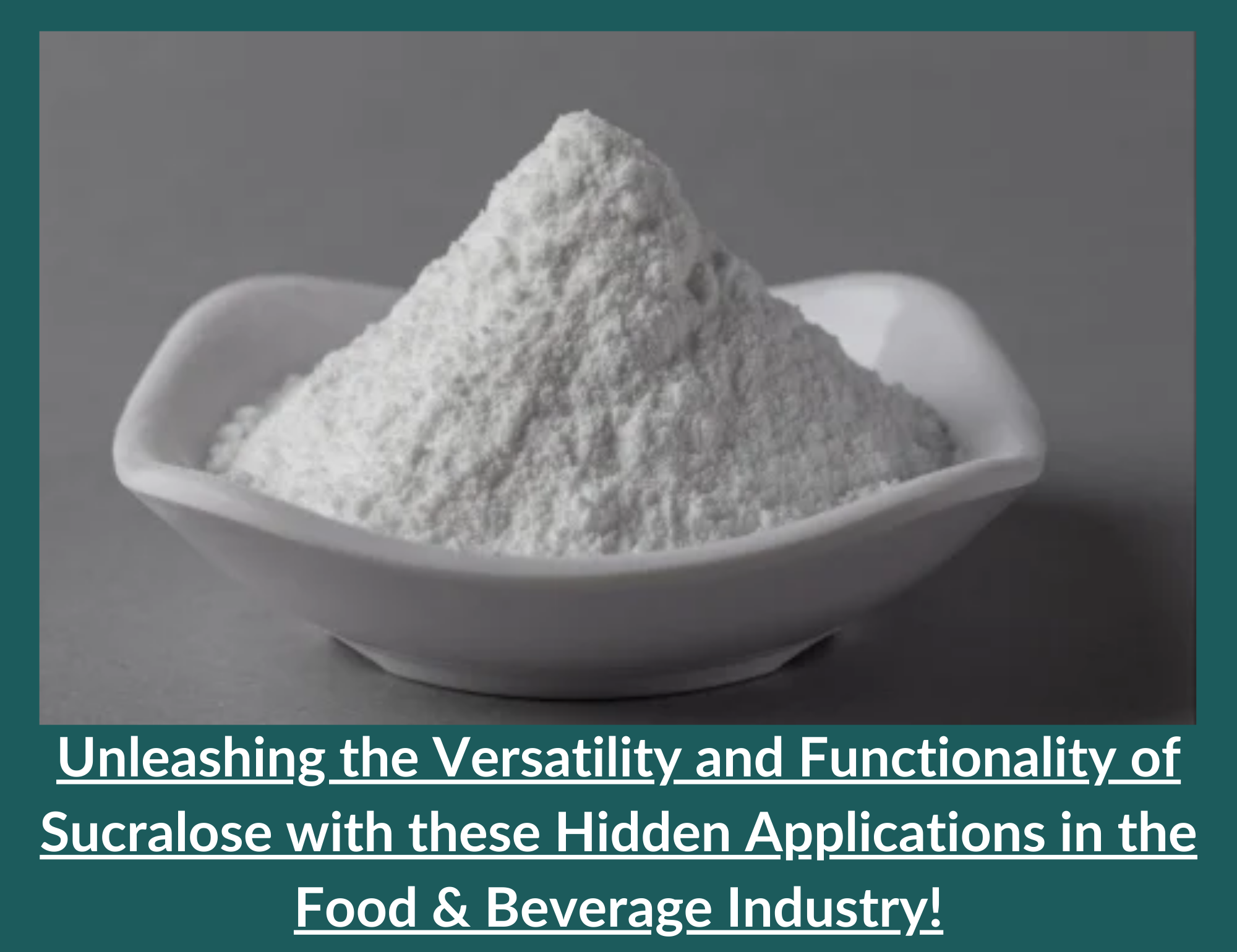Sucralose is a non-nutritive artificial sweetener commonly used in food and beverage products. It is approximately 600 times sweeter than sugar, making it an effective low-calorie substitute for sugar. In this article, we discuss the various applications of sucralose in the food and beverage industry and its functionality and versatility.
Overview of Sucralose
Sucralose is a chlorinated sucrose derivative made from sucrose through a multi-step process involving selective chlorination, protection, and deprotection.
The final product is a white, crystalline powder highly soluble in water and has a clean, sweet taste. It is approved as a food additive in over 80 countries, including the United States, Canada, and the European Union.
Applications of Sucralose
Sucralose has a wide range of applications in the food and beverage industry due to its unique properties. Its high sweetness intensity and clean taste make it a suitable replacement for sugar in various food and beverage products. Some of the most common application include:

Beverages: It is commonly used as a sweetener in various beverages, including soft drinks, fruit juices, sports drinks, and flavoured waters. Its stability in acidic environments and its solubility make it an ideal sweetener for these applications.
Baked goods: It can be used in baked goods, including cakes, cookies, and bread. Its stability at high temperatures and its ability to retain sweetness make it an effective substitute for sugar in these applications.
Dairy products: It is commonly used in dairy products such as yoghurt, ice cream, and flavoured milk. Its clean taste and stability at high temperatures make it an effective sweetener in these applications.
Confectionery: It is often used as a sweetener in confectionery products such as candy and chewing gum. It’s high sweetness intensity and stability in acidic environments make it a suitable replacement for sugar in these applications.
Functionality of Sucralose
Sucralose has several functional properties, making it an ideal sweetener for food and beverage applications. One of its most significant advantages is its high sweetness intensity. This property allows for a significant reduction in sugar content while maintaining the desired level of sweetness in the finished product.
It is also stable at high temperatures, making it suitable for use in baked goods and other products that require heat processing. Additionally, sucralose is highly soluble in water, making it suitable for various beverages and other liquid products.
Versatility of Sucralose
Sucralose is a highly versatile sweetener used in various food and beverage products. It can be used as a standalone sweetener or in combination with other sweeteners such as stevia, aspartame, or acesulfame potassium.
This versatility allows manufacturers to create products with a unique taste profile while reducing sugar content. Additionally, it can be used in low-calorie and sugar-free products, making it a suitable sweetener for various dietary needs.
It is a popular non-nutritive sweetener commonly used in food and beverage products. Its high sweetness intensity, stability at high temperatures, and solubility in water make it a versatile sweetener that can be used in various applications.
It offers a unique combination of functional properties, making it a suitable substitute for sugar in various food and beverage products.
Simplify Your Sucralose Procurement for Food Manufacturing with Hassle-free Ordering, and Unbeatable Offers. Streamline Your Ingredient Sourcing Journey Today.
Shop Now with EasyBuy!
Citations
- Linares, M. B., Sánchez-Siles, L. M., & Palop, M. L. (2011). The beneficial effects of probiotics in the regulation of the intestinal bacterial microbiota and its potential for the treatment of diabetes and obesity. Current diabetes reviews, 7(6), 410-421.
- Noda, K., Nakayama, K., & Oku, T. (2013). Serum glucose and insulin levels and erythritol balance after oral administration of erythritol in healthy subjects. European journal of clinical nutrition, 67(7), 761-766.
- Rippe, J. M., & Angelopoulos, T. J. (2015). Sucralose, Obesity, and Inflammation: A Critical Review. Critical reviews in food science and nutrition, 55(11), 1458-1466.
- Roberts, A., Renwick, A. G., Sims, J., Snodin, D. J., & Sucralose Toxicity Study Group. (2000). Sucralose metabolism and pharmacokinetics in man. Food and chemical toxicology, 38 Suppl 2, S31-41.
- Schiffman, S. S., Rother, K. I., & Sucralose Toxicity Information Center. (2013). Sucralose, a synthetic organochlorine sweetener: overview of biological issues. Journal of toxicology and environmental health. Part B, Critical reviews, 16(7), 399-451.
- Swithers, S. E., & Davidson, T. L. (2008). A role for sweet taste: calorie predictive relations in energy regulation by rats. Behavioural neuroscience, 122(1), 161.








